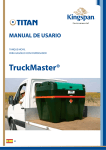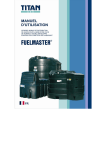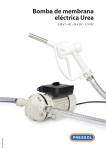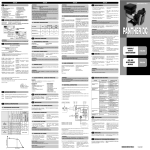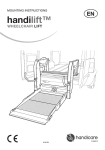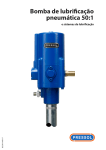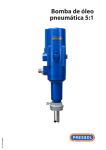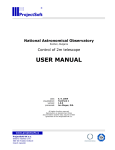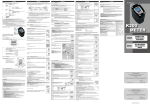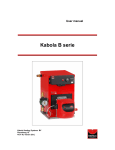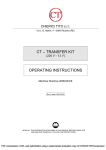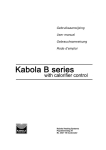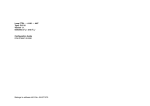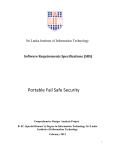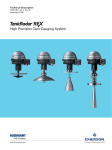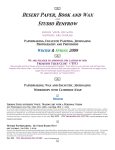Download TruckMaster®
Transcript
USER’S MANUAL PORTABLE DIESEL OIL TANK AND DISPENSER TruckMaster® EN 2 INSTRUCTION MANUAL 2007 TRUCKMASTER ® PORTABLE DIESEL OIL TANK AND DISPENSER TITAN EKO LTD. CONTENTS: I. Application ........................................................................................................................ 5 II. Technical parameters and equipment ............................................................................. 5 III. Guidelines for use ........................................................................................................... 8 1. Diesel oil properties ................................................................................................. 8 2. Operation ................................................................................................................. 8 3. Additional requirements concerning transport of less than 1000 litres of diesel oil................................................................................................ 9 4. Transport and storage ............................................................................................. 10 5. Required documentation ......................................................................................... 11 6. Vehicle crew training ............................................................................................... 11 7. General safety measures ........................................................................................ 12 8. Owner’s responsibilities .......................................................................................... 12 9. Periodic inspections ................................................................................................. 12 IV. Guarantee conditions ...................................................................................................... 14 V. Basis for the instruction manual......................................................................................... 15 VI. Complaint form ............................................................................................................... 17 VII. Inspection report ……………………………………………………………………………… 19 VIII. Instruction Manual for PIUSI 12V pump......................................................................... 21 IX. Instruction Manual for PRESSOL 12V pump.................................................................... 35 3 I. APPLICATION. TruckMaster® is a mobile solution for transporting and distributing diesel oil for private, noncommercial purposes. Some of its applications include supplying heavy equipment such as tractors, diggers or combine harvesters with oil on demand wherever this equipment is in operation. Only diesel oil can be used with the tank. No other liquids such as petrol can be stored in it. TruckMaster® meets the requirements under the European Agreement concerning the International Carriage of Dangerous Goods by Road, commonly known as ADR (and thus herafter referred to). Disclaimer: The present Instruction Manual is purely informative and does not constitute a source of law. Any user is required to make sure that the measures prescribed in the Manual are sufficient to assure safe operation. Following the Manual’s instructions does not exempt a user from obeying regulations under local law. The Instruction Manual was drawn up on the basis of the norms prescribed in the 2007 European Agreement concerning the International Carriage of Dangerous Goods by Road (ADR). IMPORTANT! For transporting an amount of oil not exceeding 1,000 litres using TruckMaster® in accordance with the present Instruction Manual, no further ADR requirements need to be met. On each occasion, precautions need to be taken against releasing the transported liquid from the tank. Legal basis: ADR 1.1.3. Agreement 4 II. TECHNICAL PARAMETERS AND EQUIPMENT. MEASUREMENTS: SYMBOL TM 430 TM 900 Nominal capacity [l] 400 850 Length [m] 1.15 1.4 Width [m] 0.81 1 Height [m] 0.86 1.21 Net weight [kg] 64 97 EQUIPMENT: 1. Single-jacket 400 or 850-litre tank: - material: UV-stabilised medium-density polyethylene, - nominal capacity amounts to 95% of flow capacity, - the tank is fitted with a partition to limit liquid sloshing within it, - the top of the tank has four holes for fitting lifting sling shackles for loading or transporting the device. 2. Standard version of TruckMaster® is fitted with: - 12V DC pump with a maximal capacity of 35 l/min, - flexible suction hose finished with a netting filter, - shut-off valve on the suction side of the pump, - 0,75 inch, 4-metre-long flexible hose with automated discharge nozzle stopping oil flow on reaching the maximal oil level in the tanked machine. 3. Float sensor with an analogue display dial for measuring the liquid level in the device. 4. Vent for regulating pressure during tanking and discharging. Its construction does not allow oil out of the tank during transport. 5. Oil inlet (a 2-ich ferrule screwed on the outside). 6. Lockable cover. 5 TM900 1. 2. 3. 4. 5. 6. 7. 8. 9. TM430 12 V DC pump. Oil inlet (a 2-ich ferrule). Automated discharge nozzle with a handle. 4m x 0,75 inch dispenser hose. Suction hose with a netting filter. Vent. Shut-off valve. Liquid level sensor. Partition preventing sloshing. *The actual equipment can vary, depending on the version of the TruckMaster® 7. Tank labelling, as required under the terms of the ADR agreement: Tank cross-section a) Rating plate: UN certificate number Date of last leakproofness test Date of last tank inspection Device serial number TM430 6 TM900 UN certificate number Date of last leakproofness test Date of last tank inspection Device serial number Full certificate numbers of individual pieces of equipment: U N 31 31H2/Y**--/NL/Truckmaster 413/0/575 (TM430) U N 31 31H2/Y**--/NL/Truckmaster 448/0/1237 (TM900) **-- indicates the month and year of production. b) ADR Label based on template 3 with “UN1202” notice: The tank, as each dangerous material packaging, should be clearly and permanently labelled in an accessible place. Its owner or user is obliged to keep labelling provided by the manufacturer legible and clear. 8. Optional equipment: - 24V DC or 230 V AC pumps, - digital flowmeter, - oil filter, - metal shackles for lifting the tank with lifting slings (see photograph). 7 III. GUIDELINES FOR USE 1. DIESEL OIL PROPERTIES. The basic source of information on a dangerous substance is its Material Safety Data Sheet. To obtain it, refer to your diesel oil manufacturer. Main hazards posed by diesel oil: Diesel oil is inflammable and toxic, thus dangerous for both man and the environment. If inhaled or swallowed, it can be irreversibly detrimental to health, for instance it can cause damage to the lungs or the alimentary system. Toxic to both land and water wildlife, diesel oil can cause lasting damage to the environment. The substance also increases fire hazard, as its vapours mixed with air are highly explosive and, being heavier than air, accumulate near the ground and floors in buildings. Transport classification: UN number: 1202 UN packing group: III Hazard ID: 3 Inflammable liquid Name: Diesel oil, gas oil or light heating oil Amount exempt: 1 000 litres 2. OPERATION. The TruckMaster® portable oil dispenser was designed for lasting, failsafe and maintenancefree operation, as far as possible. For safe use, before first filling the tank, examine it for any missing elements and any possible damage having arisen during transport. If the tank is complete, it can be safely used after filling it with oil and connecting the pump to power supply. To avoid the environmental hazards caused by diesel oil, the following guidelines should be followed: Fill the tank through its 2-inch inlet ferrule only. a) Do not fill the tank with more than its nominal capacity. b) Do not store impure oil, as this can result in irreversible damage to the tank’s pump system. c) Before starting to use the tank, read and follow the Instruction Manual for the pump and, if applicable, for the flowmeter (optional equipment). d) Transport and store the tank in conditions that assure safety from mechanical damage to the tank’s jacket. Maintain the TankMaster’s® equipment in good condition. e) TruckMaster® can only be operated by persons of full legal age who have been properly trained. f) Control and clean netting filters at the suction hose and the pump at regular intervals. 8 g) Do not make any alternations in the construction of equipment or use the tank for any other purpose than prescribed without consulting the manufacturer. h) If the device or any of its component is damaged in any way, cease using it until the damage has been repaired. If the tank is found to be untight, immediately pump out any oil into another container and notify the nearest Titan Eko branch. i) If the inside of the tank is impured, have it cleaned by a professional company. j) Keep unauthorised persons away from the device. 3. ADDITIONAL REQUIREMENTS CONCERNING TRANSPORT OF LESS THAN 1000 LITRES OF DIESEL OIL. Apart from meeting the requirements under the road traffic law, vehicles transporting the TruckMaster® device should be fitted with the following: a) Fixing equipment: Guidelines for fixing: To fasten the device use only properly labelled equipment in good technical condition. Depending on the version, the device can generate the following forces during transport: TM430 – approximately 350 daN (towards the front) TM900 – approximately 760 daN (towards the front) This force needs to be balanced by a counteractive force of a value not lower than prescribed above. Some of the measures to secure the device for transport include fixing it to a vehicle by means of beams or struts. Alternatively, it can be fixed with belts, fastened to shackles mounted on the TruckMaster®. Fasten one end of a belt to a shackle on the device and the other to a fixing point on the vehicle. Do not fasten more than one belt to a shackle. To make the fixing even safer, antiskidding mat can be laid under the device. While choosing fixing belts, pay attention to their LC parameter, indicating the maximal force generated by a belt. A vehicle for transporting the device should be equipped with the following: b) At least one portable A/B/C fire extinguisher with at least 2 kg of powder. c) A wedge for blocking wheels (at least one for each vehicle), appropriate for the vehicle’s weight and wheel diameter. d) Warning signs (such as reflective cones, triangles, or orange flashlight with power supply independent from the vehicle’s electrical system), as required by the local law. e) Appropriate warning vest or other warning clothing (e.g. clothing specified in European Norm EN 471) for each person in the vehicle. 9 f) In case the TruckMaster® has a leakage during transport, a vehicle carrying it should be equipped with at least 2 kg of a sorptive material (sorbent, sand or woodchips), with mats, foil, sleeves as well as a broom and shovel of a non-sparking material such as plastic, and other measures to prevent oil from spilling into drainage catch pits and ground waters. 4. TRANSPORT AND STORAGE a) Transport the device only on vehicles suitable for this purpose, that is fitted with (at least) fixing points allowing to fasten it to the vehicle for transport, assuring that the device is immobilised and safe from damage. b) The cargo space of a vehicle must be smooth and without sharp edges. c) If filled with oil, the device can only be loaded onto and unloaded from a vehicle by means of a forklift or a crane, using lifting slings fastened to four shackles mounted on the device. d) Transport and store the tank in conditions that assure safety from mechanical damage to the tank’s jacket. Maintain the TruckMaster’s® equipment in good condition IMPORTANT! Each of the four shackles must be fitted with separate sling. e) Always close the shut-off valve of the suction pump for transport and storage. Open it only for tanking a vehicle. f) Never push or roll the TruckMaster® on the ground. g) For transport, make sure that: - the tank’s cover and inlet ferrules are closed and secured, - the discharge nozzle is placed in its handle, - the pump’s power supply is disconnected and the wire is coiled on its handle. - the dispenser hose is coiled in a way that assures that it is safe from damage. h) As in the case of other dangerous materials, during transport of diesel oil only vehicle crew members are allowed on board the vehicle (no passengers allowed). i) One vehicle can only transport amounts equal to or lower than 1000 litres of diesel oil, which amounts to one TM 900 or two TMs 430. To transport more oil, all ADR regulations must be followed. To do it, a company must appoint a road transport advisor, entitled to issue binding guidelines for the transport of oil. j) Never enter a vehicle transporting oil with lighting devices with a flame. No lighting devices can have metal surfaces that can strike a spark. While handling the tank, smoking is forbidden both inside the vehicle and in its proximity. k) The engine of a vehicle transporting the tank can only be running during loading and unloading the device if it is necessary for the operation (e.g. when pumps or other equipment need to be powered) and when the local legal regulations allow for it. In all other cases, the engine must be off. 10 l) Always apply the parking brake while parking a vehicle transporting a dangerous material, including diesel oil. m) The TruckMaster® tank and dispenser can be used for storing oil for a certain period of time. In this case, store it in a warehouse, observing all fire-prevention and Health and Safety regulations there. 5. REQUIRED DOCUMENTATION. Apart from documents required under separate regulations, a vehicle transporting the TruckMaster® should be provided with a packing slip as required under ADR regulations, containing the following information on a dangerous substance, material or other good to be transported: a) “UN” letters, b) UN number, c) Correct transport name of the material and, if required, its technical, chemical or biological name, d) Warning label numbers and, in brackets, additional label numbers, if applicable, e) ADR material packing group number, if assigned, f) Number of pieces of transported goods or packaging of material, g) Total amount of transported dangerous material (capacity, gross weight or net weight), h) For amounts smaller than 1000 litres, enter the following in the packing slip: “The cargo does not exceed limits specified under point 1.1.3.6” Note: In most cases, oil dealers, professionally engaged in road transport, will provide their assistance in dealing with the required documentation. 6. VEHICLE CREW TRAINING The driver and other crew members should be acquainted with regulations concerning the transport of dangerous goods. Furthermore, they should be provided with detailed training on those dangerous material transport regulations that are directly related to their duties and responsibilities. The training should be arranged and registered by the owner of the TruckMaster®, as required by local regulations. In particular, the training should cover, among other things, guidelines for conduct in the event of an accident such as fire or leakage. 7. GENERAL SAFETY MEASURES Persons involved in dangerous goods transport are required to take proper precautions against any predictable hazards in order to avoid damage to property and injuries to people or to minimise their impact, if unavoidable. In the event of a direct threat to public safety, persons involved in dangerous goods transport should notify rescue services and provide them with information relevant to the rescue operation. The precise responsibilities of these persons are specified in ADR regulations and the law of any country. In the event of a leakage or spillage during transport or in a warehouse or reloading point, a person who notices it is obliged to: a) stop any operations conducted in the area of the accident, b) immediately help any affected persons after making sure that it is safe to enter the area of the accident, c) notify a superior, d) the manager of the warehouse or the area of the accident or a person appointed by them directs the rescue operation and calls fire-fighters if necessary. 11 8. OWNER’S RESPONSIBILITIES. The owner’s responsibilities include: a) supervising the device by periodic inspections and overhauls. This can be conducted by another authorised company. b) Conducting control inspections not less frequently than once a year and drafting reports on the results. The reports are to be kept as long as the device is used for transporting a dangerous substance (diesel oil). Report templates are available in chapter VII. c) Commissioning any justified inspections and conducting periodic inspections at intervals not longer than 2.5 and 5 years, respectively. d) Providing device operators with proper training. e) Informing a possible new owner of the device about periodic controls and inspections conducted so far and providing them with the documentation for the device. 9. PERIODIC INSPECTIONS. The checks or inspections specified below should be conducted by an authorised inspection authority (in Poland, this institution is Technical Supervision Office for Transport or Transportowy Dozór Techniczny). Examinations of a TruckMaster® should be conducted in accordance with ADR regulations, as described below: Checks by an inspection authority (not less frequently than every 5 years): a) construction (for any unauthorised changes) and proper labelling, b) general condition of both the outside and inside of the device, c) proper functioning of control and operation equipment. (not less frequently than every 2,5 years): d) leakproofness at pressure of 0,2 bar, e) general condition of both the outside elements of the device f) proper functioning of control and operation equipment. 12 Checks by the owner (not less frequently than once a year): a) proper labelling, b) general condition of both the outside and inside of the device c) proper functioning of control and operation equipment. Inspection chart Operation Leakproofness test (control pressure – 0,2 bar) External element condition check External element condition check Seal exchange Internal element condition check Construction and labelling check Construction and labelling check Interval (years) 2½ Agent: Inspection authority 1 User 2½ Inspection authority 5 1 User User 1 User 5 Inspection authority Make sure to permanently mark the date of the last leakproofness test (month and year, e.g. 09/07) on the device’s rating plate. Keep inspection reports for future reference. If the device is sold, provide the new owner with all reports. If the results of a check or inspection are negative, have the device repaired. 13 IV. GUARANTEE CONDITIONS 1. The manufacturer grants the following guarantees: - a five-year guarantee for the tank’s leakproofness - a year’s guarantee for the dispenser system and other equipment 2. If a fault arises, contact the nearest Titan Eko branch. This booklet contains a template for a Complaint Form. To report a fault, copy it, fill in and fax to the nearest Titan Eko branch. Here is a list of TITAN EKO branches: Country Address Phone Fax Belgium Zwaaikomstraat 5 Roeselare, B8800 +32 51 48 51 42 +32 51 48 51 53 Czech Republic & Slovakia Vážní 908 500 03 Hradec Králové +42 0 495 433 126 +42 0 495 433 127 Denmark Amerikavej 1 7400 Fredericia +45 583 83 851 +45 583 83 861 France 29 rue Condorcet 38090 Villefontaine +33 (0)4 74 99 04 56 +33 (0)4 74 94 50 49 Germany Am Schornacker 2 D-46485 Wesel +49 (0) 281 95250-45 + 49 (0) 281 95250-50 Great Britain Ireland College Road North, Aston Clinton Aylesbury, Buskinghamshire, HP22 5EW Seapatrick Road Seapatrick / Banbridge Co Down / BT32 4PH +44 1296 633000 +44 1296 633001 +44 (0)28 40 62 62 60 +44 (0)28 40 62 62 59 The Netherlands Damweg 2B 3421 GS Oudewater + 31 348 568005 + 31 348 568466 Poland ul. Topolowa 5 62-090 Rokietnica +48 61 814-44-00 +48 61 814-54-99 Spain Lino, 8 – 1 28 020 Madrid +34 91 571 56 90 +34 91 571 56 44 Sweden Skogsekebyvägen 45 137 54 Tungelsta +46 (0)8 410 300 46 +46 (0) 701 417 685 3. Faults revealed in the guarantee period will be repaired within two weeks from fault report (submitted in writing). The guaranteed time for the manufacturer’s reaction is 48 hours (two working days). Faults can be reported 24 hours a day. A fault report is found effective if submitted from 8 a.m. to 4 p.m. on working days and if submitted during a holiday, the report time will be 8 a.m. of the following working day. 4. By ordering a guarantee service, an owner agrees to accept invoices for any relevant services not covered by the Guarantee, issued by an authorised service. Titan Eko. Sp. z o.o. (Ltd.) verifies submitted complaints and supports both the client and the authorised service in solving any problems but it is not a party in transactions between customers and authorised services. 14 5. The guarantee does not cover standard equipment maintenance operations, such as cleaning filters, exchanging batteries or calibrating the flowmeter. 6. A user loses guarantee entitlements in the following situations: - the device is damaged as a result of improper transport, operation or storage, the device does not undergo proper maintenance, there is mechanical damage to the device, for instance arising from vandalism, the device is damaged as a result of attempts at repairing or modifying it by a company different than a service authorised by the manufacturer, the product is used for a purpose different than prescribed 7. Titan Eko Ltd. will not be liable for any damage arising as a result of improper use (out of keeping with the Instruction Manual) of the device. V. BASIS FOR THE INSTRUCTION MANUAL. 1. ADR 2007 - The European Agreement concerning the International Carriage of Dangerous Goods by Road, issue 01/01/2007. 2. Certificate granted by TNO Certification B.V.Packaging Research for TM430 - 413/0/575. 3. Certificate granted by TNO Certification B.V.Packaging Research for TM900 - 448/0/1237. 15 COMPLAINT FORM date: .................. SERVICING REQUEST For: Titan Eko’s client: Client code: COMPANY NAME: ADDRESS: CONTACT PERSON: tel: ………………………………. fax: ............................................ Product address: COMPANY NAME: ………………………………........................ ADDRESS:..…………………………………………...................... .. CONTACT PERSON: ……………………………...................... tel: ………………………………. fax: ............................................ Indicate the date and time when the product is available for servicing or collection: ................................................................................................... . The faulty product will be returned to Titan Eko: YES / NO TITAN EKO Sp. z o.o. 62-090 Rokietnica ul. Topolowa 5, Poland tel.:+48 61 814 44 00 fax:+48 61 814 54 99 DOCUMENT “R” NUMBER...................................................... . DATE ............................................................ CORRECTION NOTE NUMBER...................................................... DATA ............................................................ DOCUMENT “D” NUMBER...................................................... DATE A new product will be supplied on condition that the faulty one has been returned: YES / NO TruckMaster* version: TM 430 TM 900 Flowmeter:....................................... Power supply*: 12V DC 24V DC 230V AC (*cross out where applicable) Serial number: ® (the spot with the TruckMaster serial number is indicated with arrows in the Guarantee Card) Date of purchase: Guarantee Card Number: CAUSE OF COMPLAINT / FAULT DESCRIPTION: Name .................................................................... Signature …................................................ Note that if a fault is found to have arisen from improper use or installation of the product, the you will be asked to incur servicing costs. CONDUCTED REPAIR WORK: Name.................................................................... Signature…................................................ DECISION (SALES DEPARTMENT): Name.................................................................... Signature …................................................ 16 VII. INSPECTION AND CHECK REPORT (FOR INSPECTIONS AND CHCEKS PERFORMED BY OWNER/USER) Tank inspection report card Manufacturer: Address: Titan Eko Sp. z o.o. (Ltd.) Topolowa 5 62-090 Rokietnica U N UN Certificate no. 31 31H2/Y………/NL/Truckmaster ……………........................ (fill in according to label on tank) Tank serial number: …………………………………… Nominal capacity:……...................... (fill in according to label on tank) Owner (name, address, telephone) User (name, address, telephone) ……………………………………………… ………………………………………................. ………………………………………………. ………………………………………................ ……………………………………………….. ………………………………………................ Commissioning inspection / Periodic check performed by user/owner on a yearly basis Controller’s full name Inspection date External condition Internal condition Equipment Labeling legibility Report coding: O = pursuant to specifications and instructions X = specifications and instructions In case of irregularities, fill in the fault and repair report. 17 Fault and Repair Report Full name and date 18 Description of faults and measures taken to repair them USE AND MAINTENANCE MANUAL BY PASS CARRY 2000 A. INDEX A Index B Machine and Manufacturer Identification C Declaration of Conformity D Machine Description E Technical Data E1 Performance Specifications E2 Electrical Data F Operating Conditions F1 Environmental Conditions F2 Electrical Power Supply F3 Working Cycle F4 Fluids Permitted / Fluids Not Permitted G Moving and Transport H Installation H1 Disposing of the Packing Material H2 Preliminary Inspection H3 Positioning the Pump H4 Connecting the Tubing H5 Considerations Regarding Delivery and Suction Lines H6 Configurations H7 Electrical Connections I Initial Start-Up L Daily Use M Problems and Solutions N Maintenance O Noise Level P Disposing of Contaminated Materials 19 20 B. MACHINE AND MANUFACTURER IDENTIFICATION Available Models: • BY PASS 2000 12V and 24V • CARRY 2000 12V and 24V • BATTERY KIT 2000 12V and 24V MANUFACTURER: PIUSI SPA VIA PACINOTTI - Z.I. RANGAVINO 46029 SUZZARA (MN) IDENTIFICATION PLATE (EXAMPLE WITH THE FIELDS IDENTIFIED): PRODUCT CODE PRODUCTION YEAR MODEL TECHNICAL DATA MANUAL ATTENTION Always check that the revision level of this manual coincides with what is shown on the identification plate C. DECLARATION OF CONFORMITY DECLARATION OF CONFORMITY The undersigned, representing the following manufacturer PIUSI S.p.A. 46029 SUZZARA (MANTOVA) ITALY hereby CERTIFIES that the equipment described below: BY PASS 2000 12V E 24V • CARRY 2000 12V E 24V • BATTERY KIT 2000 12V E 24V Complies with the following directives: • 89/336 EEC (Electromagnetic Compatibility Directive EMC) and subsequent amendments • 73/23 EEC (Low-Voltage Directive) and subsequent amendments • 98/37 CEE (Direttiva Macchine) e successive modifiche EN 292-1 - Safety of Machinery – Basic Concepts, General Principles for Design - Basic terminology, methodology. EN 292-2 - Safety of Machinery – Basic Concepts, General Principles for Design - Technical principles and specifications. EN 294 - Safety of Machinery – Safety distances to prevent danger zones being reached by the upper limbs. EN 61000-6-1 - Electromagnetic compatibility - Generic standards - Immunity for residential, commercial and light-industrial environments. EN 61000-6-3 - Electromagnetic compatibility - Generic standards - Emission standard for residential, commercial and light-industrial environments. 21 EN 60204-1 - Safety of Machinery – Electrical equipment of machines – General requriments. EN 60335-1 - Household and similar appliances - Safety - General requirements. EN 60335-2-41/A1 - Household and similar appliances - Safety - Particular requirements for pumps. EN 60335-2-75 - Household and similar appliances - Safety - Particular requirements for commercial dispensing appliances and vending machines (electrical or gas powered). And is in conformity with the following Italian National Decrees: MD 31.07.1934 -Heading 1 No. XVII Approval of the Applicable Safety Rules for the Storing, Use and Transport of Mineral Oils. Last two figures of the year of CE marking: 04 Suzzara, 01.01.2004 OTTO VARINI, Chairman D. MACHINE DESCRIPTION PUMP: Self-Priming, volumetric, rotating vane pump, equipped with by-pass valve. MOTOR: Brush motor, DC, low tension with intermittent cycle, closed type in protection class IP55 according to CEI-EN 60034-5, directly flanged to the pump body. E. TECHNICAL SPECIFICATIONS E1. PERFORMANCE SPECIFICATIONS The performance diagram shows flow rate as a function of back pressure. Functioning Point Model (12 and 24 V) Flow Rate Voltage (Volt) Absorption (Amp) A By pass 2000 40 (Maximum Flow rate) Carry 2000 Battery kit 2000 B By pass 2000 (High Flow rate) Carry 2000 C By pass 2000 (Rated Conditions) Carry 2000 D By pass 2000 (By pass) Carry 2000 Battery kit 2000 22 38 35 0 12 18 24 9 12 19 24 10 12 21 24 11 12 23 24 13 Flow rate (l/min) Pressure (bar) ATTENTION The curve refers to the following operating conditions: Fluid Diesel Fuel Temperature 20°C Suction Conditions The tube and the pump position relative to the fluid level is such that a pressure of 0.3 bar is generated at the nominal flow rate. Under different suction conditions higher pressure values can be created that reduce the flow rate compared to the same back pressure values. To obtain the best performance, it is very important to reduce loss of suction pressure as much as possible by following these instructions: x Shorten the suction tube as much as possible x Avoid useless elbows or throttling in the tubes x Keep the suction filter clean x Use a tube with a diameter equal to, or greater than, indicated (see Installation) The burst pressure of the pump is of 20bar. E2 ELECTRICAL SPECIFICATIONS PUMP MODEL FUSES CURRENT VOLTAGE (V) MAXIMUM (AMP) BY PASS 2000 12 V DC 12 24 BY PASS 2000 24 V DC 24 13 CARRY 2000 12 V 25 DC 12 24 CARRY 2000 24 V 15 DC 24 13 BATTERY KIT 2000 12 V 25 DC 12 24 BATTERY KIT 2000 12 V 12 DC 24 13 (*) referred to operations in by-pass mode. 23 F OPERATING CONDITIONS F1 ENVIRONMENTAL CONDITIONS TEMPERATURE: min. -20° C / max +60° C RELATIVE HUMIDITY: max. 90% ATTENTION The temperature limits shown apply to the pump components and must be respected to avoid possible damage or malfunction. F2 ELECTRICAL POWER SUPPLY Depending on the model, the pump must be supplied by a single-phase alternating current line whose nominal values are shown in the table In Paragraph E2 - ELECTRICAL SPECIFICATIONS. The maximum acceptable variations from the electrical parameters are: Voltage: +/-5% of the nominal value ATTENTION Power from lines with values outside the indicated limits can damage the electrical components. F3 WORKING CYCLE The pumps are designed for intermittent use with a working cycle of 30 minutes dunder maximum back pressure conditions. ATTENTION Functioning under by-pass conditions is only allowed for brief periods of time (2-3 minutes maximum). F4 FLUIDS PERMITTED / FLUIDS NOT PERMITTED PERMITTED: x DIESEL FUEL at a VISCOSITY from 2 to 5.35 cSt (at a temperature of 37.8° C) Minimum Flash Point (PM): 55°C NOT PERMITTED: • GASOLINE • INFLAMMABLE LIQUIDS with PM < 55° C • LIQUIDS WITH VISCOSITY>20CsT • WATER • FOOD LIQUIDS • CORROSIVE CHEMICAL PRODUCTS • SOLVENTS RELATED DANGERS: • FIRE - EXPLOSION • FIRE - EXPLOSION • MOTOR OVERLOAD • PUMP OXIDATION • CONTAMINATION OF THE SAME • PUMP CORROSION • INJURY TO PERSONS • FIRE - EXPLOSION • DAMAGE TO GASKET SEALS G. MOVING AND TRANSPORT Given the limited weight and size of the pumps (see overall dimensions), moving the pumps does not require the use of lifting devices. The pumps were carefully packed before shipment. Check the packing material on delivery and store in a dry place. 24 H. INSTALLATION H1 DISPOSING OF THE PACKING MATERIAL The packing material does not require special precautions for its disposal, not being in any way dangerous or polluting. Refer to local regulations for its disposal. H2 PRELIMINARY INSPECTION x x x H3 Check that the machine has not suffered any damage during transport or storage. Clean the inlet and outlet openings, removing any dust or residual parking material. Check that the electrical specifications correspond to those shown on the identification plate. POSITIONING THE PUMP x x The pump can be installed in any position (pump axis vertical or horizontal) Attach the pump using screws of adequate diameter for the attachment holes provided in the base of the pump (see the section "OVERALL DIMENSIONS" for their position and dimension). ATTENTION THE MOTORS ARE NOT OF AN ANTI-EXPLOSIVE TYPE. Do not install them where inflammable vapours can be present. H4 x CONNECTING THE TUBING Before connection, make sure that the tubing and the suction tank are free of dirt and thread residue that could damage the pump and its accessories. x Before connecting the delivery tube, partially fill the pump body with diesel fuel to facilitate priming. x Do not use conical threaded joints that could damage the threaded pump openings if excessively tightened. x The pump is not provided with any filter. Always install a suction filter (on the BATTERY KIT model it is included) SUCTION TUBING: - Minimum recommended nominal diameter: 3/4" - Nominal recommended pressure: 10 bar - Use tubing suitable for functioning under suction pressure DELIVERY TUBING: - Minimum recommended nominal diameter: 3/4" - Nominal recommended pressure: 10 bar ATTENTION It is the installer's responsibility to use tubing with adequate characteristics. The use of tubing unsuitable for use with diesel fuel can damage the pump, injure persons and cause pollution. Loosening of the connections (threaded connections, flanging, gasket seals) can causa serious ecological and safety problems. Check all the connections after the initial installation and on a daily basis after that. Tighten the connections, if necessary. H5. CONSIDERATIONS REGARDING DELIVERY AND SUCTION LINES 25 DELIVERY The choice of pump model must be made keeping the characteristics of the system in mind. The combination of the length of the tubing, the diameter of the tubing, the flow rate of the diesel fuel and the line accessories installed can create back pressure greater than the maximums anticipated such as to cause the (partial) opening of the pump by-pass with the consequent noticeable reduction of the flow rate supplied. In such cases, to allow correct functioning of the pump, it is necessary to reduce system resistance, using shorter tubing and/or of wider diameter and line accessories with less resistance (e.g. an automatic dispensing nozzle for greater flow rates). SUCTION BY PASS 2000, CARRY 2000 and BATTERY KIT models are equipped with a self-priming pump with a good suction capacity. During the start-up phase, with an empty suction tube and the pump wetted with fluid,the electric pump unit is capable of suctioning the liquid with a maximum difference in height of 2 meters. It is important to point out that the priming time can be as long as one minute and the presence of an automatic dispensing nozzle on the delivery line prevents the evacuation of air from the installation, and, therefore, prevents proper priming. For this reason, it is always advisable to prime the pump without an automatic delivery nozzle, verifying the proper wetting of the pump. The installation of a foot valve is recommended to prevent the emptying of the suction tube and to keep the pump wet. In this way, the pump will subsequently always start up immediately. When the system is functioning, the pump can work with pressure at the inlet as high as 0.5 bar, beyond which cavitation phenomena can begin, with a consequent loss of flow rate and increase of system noise. As we have said up to this point, it is important to guarantee low suction pressure by using short tubing of a diameter equal to or larger than recommended, reducing curves to a minimum and using suction filters of wide cross-section and foot valves with the lowest possible resistance. It is very important to keep the suction filters clean because, once clogged, they increase system resistance. The difference in height between the pump and the fluid level must be kept as small as possible and, at any rate, within the 2 meters anticipated for the priming phase. If this height is exceeded, it will always be necessary to install a foot valve to allow for the filling of the suction tube and provide tubing of wider diameter. It is recommended that the pump not be installed at a difference in height greater than 3 meters. ATTENTION In the case that the suction tank is higher than the pump, it is advisable to install an antisiphon valve to prevent accidental diesel fuel leaks. Dimension the installation in order to control the back pressures due to water hammering. H6 CONFIGURATIONS The pump can be provided in 3 different configurations: BY PASS 2000 CARRY 2000 electric pump with power connection cables (12V and 24V versions), provided with fixing base. electric pump with terminal strip box electric pump with terminal strip box complete of switch, (on 12V and complete of switch (on 12V and 24V versions), with safety fuse 24V versions), with safety fuse and pincers for connection to and pincers for connection to the battery, provided with fixing the battery, provided with fixing base and handle for easier base and handle for easier moving. moving, 3/4" anti-static tube for diesel fuel dispensing, manual nozzle and foot filter to be installed at the beginning of the suction tube. 26 BATTERY KIT 2000 H7 ELECTRICAL CONNECTIONS 1. BY PASS 2000 x x Cables with faston connector coupling for connection to the power supply line; WHITE (or BROWN) cable: positive pole (+) BLACK (or BLUE) cable: negative pole (-) 2. CARRY 2000 – BATTERY KIT 2000 x x Terminal strip box (protection class IP55 in conformance with the directive EN 60034-5-97) complete of: - ON/OFF switch; - Safety fuse against short circuits and overcurrent, featuring the following characteristics: 25A for 12V models 15A for 24V models 2-m power cable complete of pincers for connection to the battery RED cable: positive pole (+) BLACK cable: negative pole (-) Black cable (OV) ON/OFF White cable (+12/24V ) Bown cable (0) Blue cable (+V) Red cable (+12/24V ) 12/24V ATTENTION IT IS THE INSTALLER'S RESPONSIBILITY TO PERFORM THE ELECTRICAL CONNECTIONS WITH RESPECT FOR THE APPLICABLE REGULATIONS. Respect the following (not exhaustive) instructions to ensure a proper electrical installation: x During installation and maintenance, make sure that the electric supply lines are not live. x Use cables characterized by the minimum cross-sections, nominal voltages and wiring-type adequate to the electrical characteristics shown in Paragraph E2 - ELECTRICAL SPECIFICATIONS and the installation environment. x Always close the cover of the strip box before supplying electrical power. x Check the correct rotation direction of the pump. If it is inverted, check the polarity of the connection cables. 27 I. INITIAL START-UP x Check that the quantity of diesel fuel in the suction tank is greater than the amount you wish to transfer. x Make sure that the residual capacity of the delivery tank is greater than the quantity you wish to transfer. x Do not run the pump dry. This can cause serious damage to its components. x Make sure that the tubing and line accessories are in good condition. x Diesel fuel leaks can damage objects and injure persons. x Never start or stop the pump by connecting or cutting out the power supply. x Do not operate switches with wet hands. x Prolonged contact with diesel fuel can damage the skin. The use of glasses and gloves is recommended. ATTENTION Extreme operating conditions with working cycles longer than 30 minutes can cause the motor temperature to rise, thus damaging the motor itself. Each 30-minute working cycle should always be followed by a 30-minute power-off cooling phase. In the priming phase the pump must blow the air initially present in the entire installation out of the delivery line. Therefore it is necessary to keep the outlet open to permit the evacuation of the air. ATTENTION If an automatic type dispensing nozzle is installed at the end of the delivery line, the evacuation of the air will be difficult because of the automatic stopping device that keeps the valve closed when the line pressure is too low. It is recommended that the automatic dispensing nozzle be temporarily disconnected during the initial start-up phase. The priming phase can last from several seconds to a few minutes, as a function of the characteristics of the system. If this phase is prolonged, stop the pump and verify: x That the pump is not running completely dry; x That the suction tubing is not allowing air to seep in; x That the suction filter is not clogged; x That the suction height does not exceed 2 m. (if the height exceeds 2 m, fill the suction hose with fluid); x That the delivery tube is allowing the evacuation of the air. When priming has occurred, verify that the pump is operating within the anticipated range, In particular: x x x 28 That under conditions of maximum back pressure, the power absorption of the motor stays within the values shown on the identification plate; That the suction pressure is not greater than 0.5 bar; That the back pressure in the delivery line is not greater than the maximum back pressure foreseen for the pump. L. DAILY USE a) If using flexible tubing, attach the ends of the tubing to the tanks. In the absence of an appropriate slot, solidly grasp the delivery tube before beginning dispensing. b) Before starting the pump make sure that the delivery valve is closed (dispensing nozzle or line valve). c) Turn the ON/OFF switch on. The by-pass valve allows functioning with delivery closed only for brief periods. d) Open the delivery valve, solidly grasping the end of the tubing. e) Close the delivery valve to stop dispensing. f) When dispensing is finished, turn off the pump. ATTENTION Functioning with the delivery closed is only allowed for brief periods (2 / 3 minutes maximum). After use, make sure the pump is turned off. M. PROBLEMS AND SOLUTIONS PROBLEM POSSIBLE CAUSE CORRECTIVE ACTION THE MOTOR IS NOT TURNING Lack of electric power Check the electrical connections Rotor jammed Check for possible damage or obstruction of the rotating components. Motor problems Contact the Service Department THE MOTOR TURNS SLOWLY WHEN STARTING Low voltage in the electric power line Bring the voltage back within the anticipated limits LOW OR NO FLOW RATE Low level in the suction tank Refill the tank Foot valve blocked Clean and/or replace the valve Filter clogged Clean the filter Excessive suction pressure Lower the pump with respect to the level of the tank or increase the cross-section of the tubing High loss of head in the delivery circuit Use shorter tubing or of greater (working with the by-pass open) diameter INCREASED PUMP NOISE LEAKAGE FROM THE PUMP BODY By-pass valve blocked Dismantle the valve, clean and/or replace it Air entering the pump or the suction tubing Check the seals of the connections A narrowing in the suction tubing Use tubing suitable for working under suction pressure Low rotation speed Check the voltage at the pump. Adjust the voltage and/or use cables of greater cross-section The suction tubing is resting on the bottom of the tank Raise the tubing Cavitation occurring Reduce suction pressure Irregular functioning of the by-pass Dispense fuel until the air is purged from the by-pass system Air present in the diesel fuel Verify the suction connections Seal damaged Check and replace the seal 29 N. MAINTENANCE BY PASS 2000, CARRY 2000 and BATTERY KIT are designed and constructed to require a minimum of maintenance. In any case always bear in mind the following basic recommendations for a good functioning of the pump: x On a weekly basis, check that the tubing joints have not loosened, to avoid any leakage. x On a monthly basis, check the pump body and keep it clean of any impurities. x On a weekly basis, check and keep clean the line suction filter. x On a monthly basis, check that the electric power supply cables are in good condition. x Check on a monthly basis and keep clean the dispensing nozzle provided with the BATTERY KIT model. Anyway keep clean any other final check valve installed. x Check on a monthly basis and keep the suction filters clean. O. NOISE LEVEL Under normal working conditions the noise emission from all models does not exceed the value of 70 db at a distance of 1 meter from the electric pump. P. DISPOSING OF CONTAMINATED MATERIALS In the event of maintenance or demolition of the machine, do not disperse contaminated parts into the environment. Refer to local regulations for their proper disposal. 30 Q. EXPLODED DIAGRAM AND SPARE PARTS ATTENTION Always specify the spare part position number with the product code and serial number. Position Component Description Quantity 01 KIT SEALING BP2000 1 02 COMPENSATING RING (29,7/22,5/0,3) 1 05 PUMP BODY BP2000 1 07 KIT BY-PASS VALVE 1 08 KIT NR. 5 VANES 1 10 KIT ROTOR + KEY 1 11 GASKET O-RING 3206 (D.52,07 TH.2,62) NBR 70SH 1 31 13 KIT FRONT COVER 1 14 KIT BASE PUMP 1 15 - A KIT MOTOR 12V COMPLETE WITH TIE RODS 1 15 - B KIT MOTOR 24V COMPLETE WITH TIE RODS 1 16 KIT HANDLE WITH SCREW 1 17 SELF 2000 1in GAS 1 18 - A KIT TERMINAL BOX 12V + CABLE 2 MT 1 18 - B KIT TERMINAL BOX 24V + CABLE 2 MT 1 19 - A KIT FUSE 12V (FUSE 25A+SUPPORT ) 1 19 - B KIT FUSE 24V (FUSE 25A+SUPPORT ) 1 20 GASKET O-RING 2007200-N7027 d.72 TH.2 1 21 SINGLE SWITCH 1 22 TERMINAL BOX BP2000 1 23 HOSE TAIL 1in x20 GAS + O-RING 1 24 HOSE TAIL 3/4in x20 + O-RING 1 25 CLAMP 20-32-9 1 26 RUBBER HOSE CARBO/LN 10 19x27 4MT 1 27 FILTER 1" 1 R. DIMENSIONS Unit of measurement: mm 32 IX. INSTRUCTION MANUAL FOR PRESSOL 12V PUMP CONTENTS: 1. General Information 1.1 Usage Stipulations 1.2 Construction and Functional Description 1.3 Technical Data 1.4 Application Range 1.5 Operational Area Requirements 2. General Safety Advice 2.1 Safe Working Advice 2.2 Risks when Working with the Diesel Pump 3. Installation 3.1 Installing the Siphon Protection 4. Operation 5. Maintenance 6. Servicing 6.1 Replacing Worn Blades 6.2 Changing the Fuse 7. Fault Finding 8. Repairs/Service 9. EC Declaration of Conformity 10. Exploded View 33 EXPLANATION OF SAFETY ADVICE The safety advice provided in these operating instructions is categorised according to different danger levels. The different danger levels are identified within the instructions by the following symbols and identifying words: Symbol Indicates Result if the safety requirements are not observed or applied Danger Death or very serious injury Warning Possible death or serious injury Caution Possible slight or not serious injury or material damage Table 0-1: Safety Advice Classification according to Danger Type and Severity In addition, another symbol is used to indicate general tips about using the product. Symbol Indicates Meaning Note Background information or tips about how to use the product Table 0-2: General Information If the diesel pump is incorrectly installed, or used for a purpose other than that originally intended for, it can result in personal injury or damage to equipment Before starting to use the meter, read through these operating instructions carefully and completely. 34 1. GENERAL INFORMATION 1.1 USAGE STIPULATIONS x The diesel pump is to be used only for the delivery of diesel fuel and heating oil. Danger Never use it to deliver explosive fluids such as petrol, or other fluids with similar flashpoints! x It must be connected, according to the type, only to a 12 Volt- or 24 Volt-DC supply. x To ensure that usage stipulations are met, read through the operating instructions completely before using the pump and observe all stipulations. x Any departure from the usage stipulations (other fluid media, use of force) or user modifications (changes, use of non-original parts) can be dangerous and are considered as non-stipulated usage. x The user is liable for any damage resulting from non-stipulated use. x During repairs to any electrical components, the appropriate safety and test requirements are to be observed. x Only original replacement parts are to be used for any repairs, otherwise the warranty will be invalidated. 1.2 CONSTRUCTION AND FUNCTIONAL DESCRIPTION x The MOBIFIxx diesel pumps are pumps that can be used as portable or fixed units. x The diesel pumps can be fitted with a variety of PRESSOL accessories. x The diesel pumps are available in the following specifications: x MOBIFIxx, 12 V DC, 35 l/min x MOBIFIxx, 24 V DC, 35 l/min x A standard pump shipment includes: x Diesel pump in one of the above specifications x Hose and fittings x Foot valve with strainer x Nozzle valve x To prevent environmental damage the diesel pump is fitted with a siphon protection system. This means that if the discharge hose is damaged while the pump is stopped, siphon action will not empty the tank. 35 1.3 TECHNICAL DATA Pump Type MOBIFIxx 12 V MOBIFIxx 24 V Year of Manufacture See Nameplate See Nameplate Fluid temperature °C -10 to +40 -10 to +40 Connection thread G 1„ i 1„ i Current A 18 13 Power W 220 320 Fuse A 25 25 Pressure relief setting bar 1,6 1,6 Max. suction height m 3 3 Nominal delivery rate * L / min 35 35 Voltage V / DC 12 24 -1 Revolution count min 3300 3500 Safety type IP 54 54 Power cable length m 3 3 Weight kg 3,6 3,6 Hose length m 4 4 Nominal hose width mm 19 19 * under free discharge Table 1-3: Technical Data 1.4 APPLICATION RANGE The diesel pump is suitable for the delivery of diesel and heating oil only when they are not heated above their flash points. The temperature of the delivery fluids must be between –10 °C and +40 °C. The temperature limits must not be exceeded. Because the motor and switch are not explosion-protected, the pump must not x be operated in an explosion risk area. x be used to deliver fuels of danger classification A I, A II and B. 1.5 OPERATIONAL AREA REQUIREMENTS Heating oil and diesel are water polluting substances. Therefore the country specific rules and regulations regarding the delivery and storage of such fluids must be obeyed. According to § 19g WHG (Germany) the filling installation must be so constructed and built, maintained and operated, such that water pollution and/or any other environmental damage is prevented. The operator of such an installation is, according to § 19i WHG (Germany) responsible for continuous monitoring to ensure compliance with the above stated requirements at the installation. 36 2. GENERAL SAFETY ADVICE 2.1 SAFE WORKING ADVICE x The diesel pump has been designed and manufactured according to the health and safety requirements of the relevant EC guidelines. x Nevertheless, there can still be risks if the product is not set up or operated as stipulated. x Therefore, before using the diesel pump, read these operation instructions and pass them on to other users. x When operating the diesel pump, the local safety and accident prevention rules and regulations always apply, as well as the safety advice in the operating instructions. 2.2 RISKS WHEN WORKING WITH THE DIESEL PUMP Danger! Never work on a pump that is running! x Mount or remove attachments and accessories only when the pump is switched off. x For your own safety, disconnect the pump from the power supply. Danger! Do not pump contaminated fluids! x Take special care to ensure that there is no contaminant in the fluid to be pumped. x Install a strainer on the suction pipe. Danger! Damaged attachments and accessories can lead to personal injury and material damage x Suction and pressure pipes must not be kinked, twisted or stretched. x Attachments and accessories must be checked for wear, splits or other damage at all times. x Damaged attachments and accessories must be replaced immediately. x With reference to the period of use, please note the details in ZH 1/A45.4.2 or DIN 20066 Part 5.3.2. Caution! Spilled fuel can result in environmental damage x Local and country rules and regulations relating to domestic water supplies and fuel storage must be obeyed. 3. INSTALLATION x If the diesel pump is to be locally mounted 4 bolts, diameter less than 6 mm (not included) are required. x When installing the pump, ensure that it is mounted on a stable surface. Select a secure location (protected from water spray, damage and theft). x If the pump is not secured with bolts, it must be operated on a firm, level and dry base. x First, remove the plastic plugs from the suction and discharge junctions. 37 x Connect hoses to the suction and delivery connectors. Attach a strainer to the end of the suction hose. x Attach the nozzle valve to the delivery hose. x Connect the red connecting clamp to the positive-, and the black connecting clamp to the negative-pole of the power supply. Ensure that the connecting clamps are securely fixed. x The pump is now ready for operation. Note Ensure cleanliness during installation, and that all accessories/attachments are correctly connected to the pump housing. Use suitable sealing and jointing material (e.g. Teflon tape). 3.1 INSTALLING THE SIPHON PROTECTION x Remove the bolt screwed into the side of the pump housing, together with the seal (see Fig.3-1). x Screw into the same thread the supplied threaded nozzle with the new seal (see Fig. 3-2). x Connect the hose to the threaded nozzle and feed it into the tank. Note Ensure when installing the siphon protection system that the end of the hose is not immersed in the fluid. If it is, the siphon protection system will not work! Figure 3-1: Siphon Protection boring with blanking screw (as delivered) 38 Figure 3-2: Threaded nozzle for Siphon Protection screwed in place 4. OPERATION Check the diesel pump and installed accessories for completeness and damage. Replace any damaged components immediately. Never use a pump if damaged. Check the suction filter for damage each time the tank is filled/emptied and replace it if damaged. Never operate the pump without the suction filter, because the pump will not be protected against contamination by foreign bodies. x Suspend the suction hose in the tank to be emptied. Note To ensure that the tank can be completely emptied, the suction hose must reach to the bottom of the tank. x Position the nozzle valve in the container to be filled. x Operate the rocker switch to switch on the pump. Caution! Never operate the pump without delivery fluid. There is a danger of your diesel pump being damaged if operated dry. x Adjust the nozzle valve lever pressure according to the delivery rate required, or lock it in position for constant flow (only applicable to automatic control valve, not included in standard delivery). 39 Caution! Tank pump does not switch off automatically, therefore when filling, never leave the pump running without supervision. x To finish a pumping session, release the nozzle valve control lever. x Operate the rocker switch to switch off the pump. x Position the nozzle valve so that no diesel fuel can pollute the environment. Caution! Danger of product damage The power source must be the correct voltage for the pump type. 5. MAINTENANCE The diesel pump is very easy to maintain and service. Due to the operator responsibilities according to § 19i WHG (German rules), the following components must be regularly checked and replaced as necessary, to minimise the possibility of environmental or equipment damage, or personal injury: x Pump housing (2) x Delivery hose x Nozzle valve 6. SERVICING 6.1 REPLACING WORN BLADES Blade replacement will be necessary only in exceptional circumstances. Referring to Figure 10-1 x Undo the screws (12). x Remove the pump housing (2) from the motor (7). x Replace the worn blades (5) with new Original PRESSOL spare parts, ensure that they are correctly located. x Refit the pump housing (2) and secure it with the screws (12). 6.2 CHANGING THE FUSE Referring to Figure 10-1 x Undo the screws (11). x Remove the motor cover (18). x Pull the defective fuse (9) out of the fuse holder (17) and replace it with a new one with the same current rating. x Refit the motor cover (18) and secure it with the screws (11). 40 7. FAULT FINDING Fault Cause Solution Discharge rate too low Supply rate too low; motor speed too low; excessive suction line resistance; suction line too long; too many bends or fittings; filter resistance too high Check the suction line and filter; check the motor speed Discharge pressure too low Wrong rotational direction; contamination Check the rotational direction (connections to the power supply); clean the inlet port Pump runs too loudly Low pressure in the suction line; air in the suction line; defective alignment between pump and motor; supply rate too low Check the suction line; check pump to motor assembly; confirm that sufficient supply rate Leaking Defective shaft seal; defective Oring Change seals Pump rotates with difficulty Debris or foreign body in the pump; pump out of use for a long time Clean the pump Table 7-1: Fault Finding If the solutions given in Table 7-1 for solving faults do not solve the problem, please contact our customer service (Address, See Chap. 8). 8. REPAIRS/SERVICE The diesel pump was developed and produced according to the highest quality standards. Should a problem develop, despite all quality controls, please contact our customer service: Customer Service/Repair Department PRESSOL Schmiergeräte GmbH Tel. +49 911 32441-35 • Fax +49 911 32441-65 • [email protected] 41 9. EC DECLARATION OF CONFORMITY We hereby declare that the product described here, its concept and construction, including this particular model, complies with the EC requirements. Any change to the product, not approved by us, will invalidate the declaration. Product Description: MOBIFIxx 12 V DC / 24 V DC Product Type: Diesel Pump Year of Manufacture: See Nameplate Applicable EC-Directives: 89/392/EWG Anhang IIA 01.03.2007 PRESSOL Schmiergeräte GmbH ___________________________ Dipl.-Ing. Rudolf Schlenker 10. EXPLODED VIEW Nr. Description 1 Pressure spring 2 Pump housing 3 Hexagonal head screw M5x10 4 Carrying handle 5 Pump blade 6 Rotor securing key 7 Motor 8 O-Ring 74x1,8 9 Fuse 25 A 10 Rocker switch 11 Screw M4x20 12 Hexagonal head screw M5x45 13 Base plate 14 O-Ring 50x2 15 Rotor 16 Valve cone 17 Fuse holder 18 Motor cover 19 Cable gland seal 20 Cable gland nut Table 10-1: Captions for Fig. 10-1 42 Figure 10-1: Exploded View of the Diesel Pump PRESSOL Schmiergeräte GmbH • Parkstraße 7 • D-93167 Falkenstein Tel. +49 9462 17-0 • Fax +49 9462 17-208 • [email protected] • www.pressol.com 43 44 Titan Eko Sp. z o.o. Topolowa 5 62-052 Rokietnica Poland Tel.: + 48 814 44 00 Fax: + 48 814 54 99 [email protected] www.titan-eko.pl Lino, 8 – 1º 28020 Madrid Spain Tel.: +34 91 571 56 90 Fax: +34 91 571 56 44 [email protected] www.titan-ltd.es 29 rue Condorcet 38090 Villefontaine France Tel.: +33 4 74 99 04 56 Fax: +33 4 74 94 50 49 [email protected] www.titan-eko.fr Damweg 2/b 3421 GS Oudewater The Netherlands Tel.: +31 348 56 80 05 Fax: +31 348 56 84 66 [email protected] www.titan-eko.nl Zwaaikomstraat 5 Roeselare B 8800 Belgium Tel.: +32 51 48 51 42 Fax: +32 51 48 51 53 [email protected] www.titan-eko.be Vážní 908 500 03 Hradec Králové Czech Republic Tel.: +420 495 433 126 Fax: +420 495 433 127 [email protected] www.titan-eko.cz Slovakia [email protected] www.titan-eko.sk Kingspan Environmental GmbH Am Schornacker 2 D-46485 Wesel Deutschland Tel.: +49 281 95250-45 Fax: +49 281 95250 70 [email protected] www.bluestore.info www.titan-eko.de Kingspan Environmental Ltd 180 Gilford Road Portadown Co Armagh BT63 5LE Ireland Tel.: +44 28 3836 4448 Fax: +44 28 3836 4445 [email protected] www.kingspanenv.com Kingspan Miljøcontainere A/S Mørupvej 27-35 7400 Herning Denmark Tel.: +45 9626 5620 Fax: +45 9626 5628 [email protected] www.kingspanmiljo.dk Sweden Tel.: +46 841 030 046 Fax: +46 701 417 685 [email protected] www.titantank.se Kingspan Miljø NUF Gjerdrumsvei 10 D N-0484 Oslo Norway Tel.: +47 22 02 19 20 Fax: +47 22 02 19 21 [email protected] www.kingspanmiljo.no Hungary www.titan-eko.hu Russia www.titan-eko.ru Testy zgodne z EN13071 www.titan-eko.com www.roug.dk www.klargester.com













































